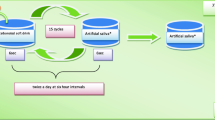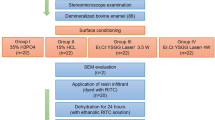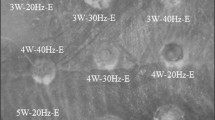Abstract
The objective of this study was to evaluate the effects of chromium:yttrium-scandium-gallium-garnet (Er,Cr:YSGG) laser irradiation on the acid resistance of dental enamel. Forty human enamel samples were divided into four groups. They were manually irradiated with an Er,Cr:YSGG laser device (λ = 2.78 µm, 20 Hz, 20 s), in a scanning mode, with and without water cooling, according to the following parameters: Group 1: 0.25 W, 62.5 J/cm2, no water cooling; group 2: 0.25 W, 62.5 J/cm2, 5.0 ml/min; group 3: 0.5 W, 125 J/cm2, no water cooling; group 4: 0.5 W, 125 J/cm2, 5.0 ml/min. No airflow was used. Afterwards, the samples were submitted to an acid challenge and assessed by cross-sectional Knoop microhardness at different depths (20, 40, 60, 80, and 100 µm) from the outer enamel surface. Average values were obtained for both irradiated and control areas in each sample and they were compared to obtain a percentage of microhardness increase. Data were analyzed by analysis of variance and Fisher’s exact test (α = 5%). The percentage of microhardness increase observed in group 1 (+23.58%) was similar to group 3 (+19.12%), but higher than groups 2 (+3.61%) and 4 (10.9%) (p < 0.05). The comparison of the depths showed that the Er,Cr:YSGG laser acted in the superficial layers of the dental enamel. The findings of the present study suggest that the energy densities of 62.5 and 125 J/cm2 were capable of increasing the acid resistance of human enamel. The presence of water during irradiation makes it difficult to obtain an enamel surface more resistant to acids.


Similar content being viewed by others
References
Kidd EA, Fejerskov OE (2004) What constitutes dental caries? Histopathology of carious enamel and dentin related to the action of cariogenic biofilms. J Dent Res 83:C35–C38
Featherstone JD, Rodgers BE (1981) Effect of acetic, lactic and other organic acids on the formation of artificial carious lesions. Caries Res 15:377–385
Featherstone JD (2000) The science and practice of caries prevention. J Am Dent Assoc 131:887–899
Selwitz RH, Ismail AI, Pitts NB (2007) Dental caries. Lancet 369:51–59
Stern RH, Vahl J, Sognnaes RF (1972) Lased enamel: ultrastructural observations of pulsed carbon dioxide laser effects. J Dent Res 51:455–460
Bader C, Krejci I (2006) Indications and limitations of Er:YAG laser applications in dentistry. Am J Dent 19:178–186
Theuns HM, Arends J, Groeneveld A (1980) Polarizing microscopy and microradiography of sound enamel. J Biol Buccale 8:229–238
Bevilacqua FM, Zezell DM, Magnani R, Ana PA, Eduardo CP (2008) Fluoride uptake and acid resistance of enamel irradiated with Er:YAG laser. Lasers Med Sci 23:141–147
Apel C, Birker L, Meister J, Weiss C, Gutknecht N (2004) The caries-preventive potential of sub-ablative Er:YAG and Er:YSGG laser radiation in an intraoral model: a pilot study. Photomed Laser Surg 22:312–317
Apel C, Meister J, Götz H, Duschner H, Gutknecht N (2005) Structural changes in human dental enamel after sub-ablative erbium laser irradiation and its potential use for caries prevention. Caries Res 39:65–70
de Freitas PM, Rapozo-Hilo M, Eduardo CP, Featherstone JD (2010) In vitro evaluation of erbium, chromium:yttrium-scandium-gallium-garnet laser-treated enamel demineralization. Lasers Med Sci 25:165–170
Apel C, Meister J, Schmitt N, Gräber HG, Gutknecht N (2002) Calcium solubility of dental enamel following sub-ablative Er:YAG and Er,Cr:YSGG laser irradiation in vitro. Lasers Surg Med 30:337–341
Fried D, Featherstone JDB, Visuri SR, Seka WTJ (1996) The caries inhibition potential of Er:YAG and Er:YSGG laser radiation. Proc SPIE 2672:73–78
Ana PA, Zezzel DM, Blay CC, Blay A, Eduardo CP, Miyakawa W (2004) Thermal analysis of dental enamel following Er,Cr:YSGG laser irradiation at low fluencies. Lasers Surg Med 34(16):53–53
Geraldo-Martins VR, Lepri CP, Palma-Dibb RG (2012) Effect of different root caries treatments on the sealing ability of conventional glass ionomer cement restorations. Lasers Med Sci 27:39–45
Geraldo-Martins VR, Tanji EY, Wetter NU, Nogueira RD, Eduardo CP (2005) Intrapulpal temperature during preparation with the Er:YAG laser: an in vitro study. Photomed Laser Surg 23:182–186
Featherstone JD (1996) Modeling the caries-inhibitory effects of dental materials. Dent Mater 12:194–197
Rehder Neto FC, Maeda FA, Turssi CP, Serra MC (2009) Potential agents to control enamel caries-like lesions. J Dent 37:786–790
Featherstone JD, ten Cate JM, Shariati M, Arends J (1983) Comparison of artificial caries-like lesions by quantitative microradiography and microhardness profiles. Caries Res 17:385–391
ten Cate JM, Shariati M, Featherstone JDB (1985) Enhancement of salivary remineralization by “dipping” solutions. Caries Res 19:335–341
Moslemi M, Fekrazad R, Tadayon N, Ghorbani M, Torabzadeh H, Shadkar MM (2009) Effects of Er,Cr:YSGG laser irradiation and fluoride treatment on acid resistance of the enamel. Pediatr Dent 31:409–413
Perhavec T, Diaci J (2009) Comparison of heat deposition of Er:YAG and Er,Cr:YSGG lasers in hard dental tissues. J Laser Health Acad 2:1–6
Fowler BO, Kuroda S (1986) Changes in heated and in laser irradiated human tooth enamel and their probable effects on solubility. Calcif Tissue Int 38:197–208
Featherstone JDB, Fried D (2001) Fundamental interactions of lasers with dental hard tissues. Med Laser Appl 16:181–194
Hsu CY, Jordan TH, Dederich DN, Wefel JS (2000) Effects of low-energy CO2 laser irradiation and organic matrix on inhibition of enamel demineralization. J Dent Res 79:1725–1730
Ying D, Chuah GK, Hsu CY (2004) Effect of Er:YAG laser and organic matrix on porosity changes in human enamel. J Dent 32:4l–46l
Hossain M, Kimura Y, Yamada Y, Nakamura Y, Yamada Y, Kinoshita JI, Matsumoto K (2001) A study on acquired acid resistance of enamel and dentin irradiated by Er,Cr:YSGG laser. J Clin Laser Med Surg 19:159–163
Visuri SR, Walsh JT Jr, Wigdor HA (1996) Erbium laser ablation of dental hard tissue: effect of water cooling. Lasers Surg Med 18:294–300
Olivi G, Angiero F, Benedicenti S, Iaria G, Signore A, Kaitsas V (2010) Use of the erbium, chromium:yttrium-scandium-gallium-garnet laser on human enamel tissues. Influence of the air–water spray on the laser-tissue interaction: scanning electron microscope evaluations. Lasers Med Sci 25:793–797
Hossain M, Nakamura Y, Kimura Y, Yamada Y, Ito M, Matsumoto K (2000) Caries-preventive effect of Er:YAG laser irradiation with or without water mist. J Clin Laser Med Surg 18:61–65
Majaron B, Sustersic D, Lukac M, Skaleric U, Funduk N (1998) Heat diffusion and debris screening I Er:YAG laser ablation of hard biological tissues. Appl Phys B 66:1–9
Ivanov B, Hakimian AM, Peavy GM, Haglund RF (2003) Mid-infrared laser ablation of hard biocomposite material: mechanistic studies of pulse duration and Interface effects. Appl Surf Sci 208–209:77–84
Acknowledgements
The authors are grateful to the Fundação de Amparo à Pesquisa do Estado de São Paulo (FAPESP), Brazil, for providing financial support (grant # 2007/08140-5 and 2008/07403-5). The authors would like to thank The Special Laboratory on Lasers in Dentistry, School of Dentistry, São Paulo University, Brazil (LELO-FOUSP), for allowing the use of the Er,Cr:YSGG laser device.
Author information
Authors and Affiliations
Corresponding author
Rights and permissions
About this article
Cite this article
Geraldo-Martins, V.R., Lepri, C.P. & Palma-Dibb, R.G. Influence of Er,Cr:YSGG laser irradiation on enamel caries prevention. Lasers Med Sci 28, 33–39 (2013). https://doi.org/10.1007/s10103-012-1056-9
Received:
Accepted:
Published:
Issue Date:
DOI: https://doi.org/10.1007/s10103-012-1056-9




